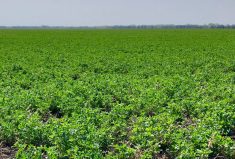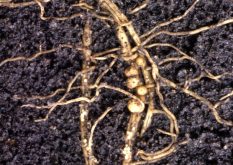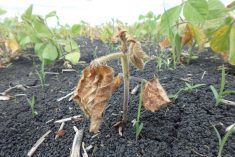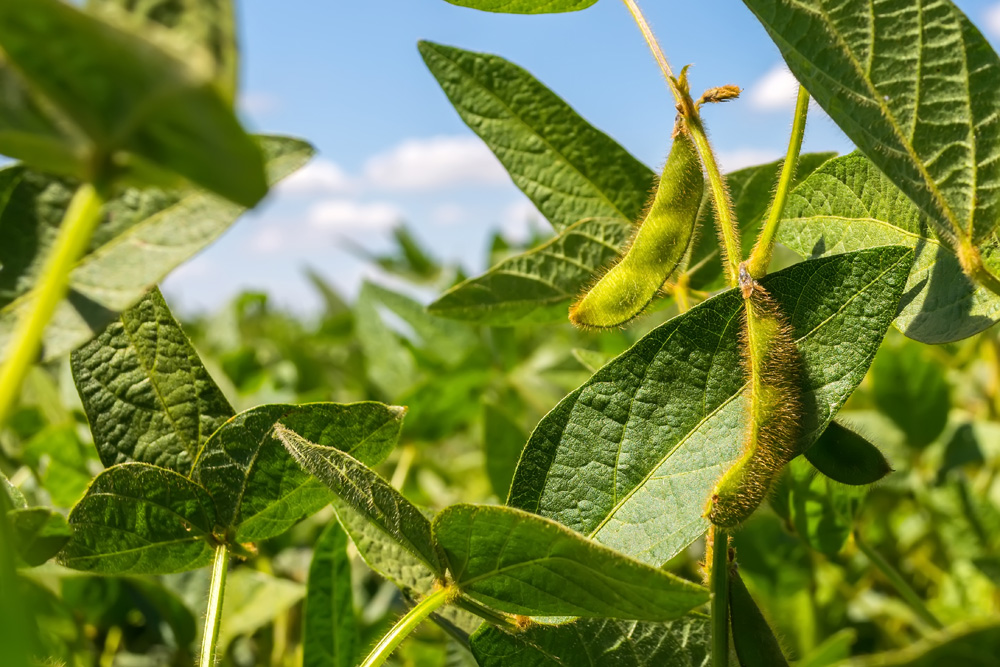While dry conditions during the 2018 growing season didn’t stop all instances of foliar, stem and root rot diseases across Western Canada, pulse growers didn’t see the high levels of pulse or soybean diseases associated with warm, moist conditions. But that doesn’t mean scouting won’t be necessary in 2019.
The main diseases in pulse and soybean crops are foliar diseases such as septoria brown spot, bacteria blight, downy mildew, stem diseases such as sclerotinia (white mould) and phytophthora (exclusive to soybeans), and root rots like fusarium, rhizoctonia and pythium.
Read Also
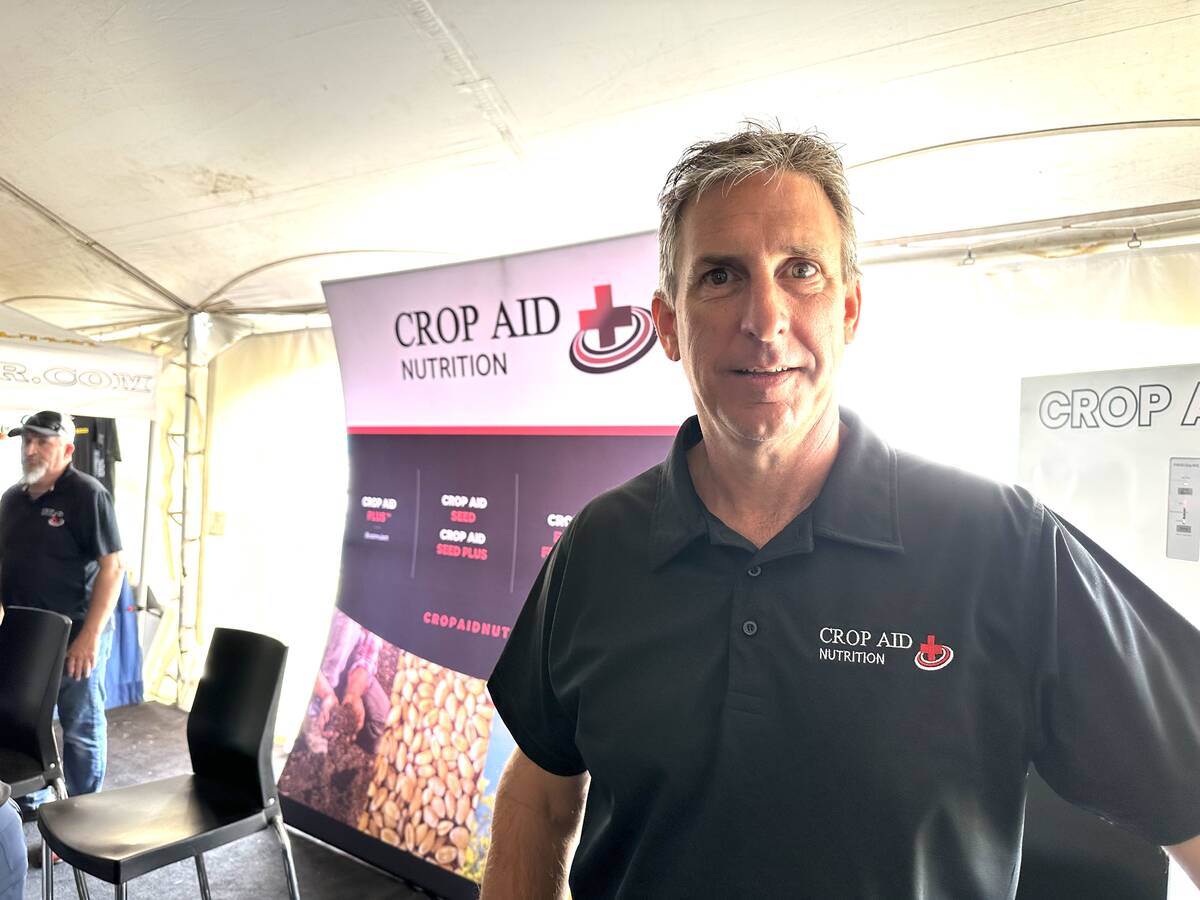
New soil treatment targets saline patches in fields
Crop Aid SS is a Saskatchewan-made spray that’s intended to help farmers manage saline soils by leaching salts away from the root zone.
Foliar diseases are very conspicuous. “If you’re walking in the field you see yellow spots on the leaves, and it looks bad, but the foliar diseases actually have the lowest impact on yield and quality so we’re encouraging farmers and agronomists to keep an eye out for the root and the stem diseases,” says Cassandra Tkachuk, production specialist with the Manitoba Pulse & Soybean Growers (MPSG). “White mould is a stem disease and we don’t always see it and not in high numbers. We keep track of how prevalent these diseases are year by year and if there are any new ones, we’re trying to identify if they’re here yet. The root rots including phytophthora and fusarium, are our top root rots. There’s also rhizoctonia and pythium but we don’t see those ones very much.”
Root rot issues
Saskatchewan saw some root rot issues in 2018 despite the dry weather, not that it impacted yields that much in the drier areas, says Sherrilyn Phelps, agronomy manager with Saskatchewan Pulse Growers (SPG). “In peas and lentils, we’re seeing a lot of fusarium as well as aphanomyces. With soybeans, we did see some phytophthora stem rot this year, which was confirmed by lab tests. Root rots on some of the other pulses, chickpea and fababean, weren’t much of an issue.”
AFFC pathologists, Debra McLaren in Brandon and Bob Conner in Morden are conducting research into soybean root rot diseases, and samples are sent to them each year for analysis.
In Manitoba, root disease surveys of soybean have been conducted with the assistance of staff from Manitoba Agriculture and the Manitoba Pulse & Soybean Growers. “Our research has shown that root rot of soybean in Western Canada is primarily caused by several species of fusarium,” says McLaren.
Drs. Sheau-Fang Hwang and Kan-Fa Chang at the Crop Development Centre North in Edmonton recently reported on the occurrence of Fusarium proliferatum as a new root rot pathogen of soybean in Canada. The same fusarium species can also cause damping-off or seedling blight of soybeans in which the seedlings die before or shortly after they emerge.
Field studies were conducted at Morden and Brandon to determine the effects of different root rot pathogens on the yields of soybean varieties with different levels of resistance. “It is critically important to quantify the magnitude and nature of damage caused by root disease in order to determine the need for developing and implementing new disease management strategies,” says Conner. “Understanding the disease-yield relationships is a prerequisite for measuring the agronomic efficacy and economic benefits of the management measures.”
Rotation is key
Crop rotations can be helpful in controlling root rot, soybean cyst nematode (SCN) and phytophthora rot. If inoculum levels are high, Conner says, “crop rotations of five years or more with non-host crops like cereals and certain oilseed crops is effective in reducing the inoculum levels of the pathogens in the soil, so there is less disease and yield loss when soybeans are grown.”
Planting soybeans in warm, well-drained soils will reduce the severity of root diseases of soybeans. Agricultural practices that promote plant growth such as adequate soil fertilization and avoiding soil compaction and salinity will also reduce the adverse effects of root diseases on soybeans.
A number of fungicide seed treatments are available to control seedling blight caused by root pathogens, but most products do not persist long enough to effectively control root diseases past the seedling stage. “Many soybean cultivars have been developed that carry resistance to many of the common races of P. sojae or to the SCN, but growing resistant cultivars in short rotations should be avoided in order to prevent the buildup of new races that can attack formerly resistant cultivars,” advises Conner. “In future, resistance to root rot diseases in soybeans will become more common enabling better disease control and reducing losses in seed yield.”
This year McLaren, Conner and their team have expanded the scope of their studies on root rot and phytophthora rot to include all of the soybean-growing regions in Western and Eastern Canada. “We have co-operating scientists and crop specialists in each province, who will be conducting annual surveys of soybean root diseases to determine the incidence and severity of each disease and to identify the prevalent root pathogens and detect the presence of any new root diseases or new races of pre-existing pathogens.”
Ascochyta resistance found
Chickpea growers should note the level of ascochyta resistance found in a 2018 southern Saskatchewan survey. Chickpea samples (leaves, stems, pods, and/or seeds) showing ascochyta infection were submitted to Michelle Hubbard, research scientist with AAFC at Swift Current.
These samples were confirmed resistant to strobilurin fungicides. “These results indicate that in Saskatchewan there may be a high level of strobilurin resistance in chickpea ascochyta, which means fungicide plans need to be re-evaluated to ensure alternative modes of action are being used,” says the survey. “Results from the limited samples from 2018 indicate that strobilurin fungicides may no longer provide effective control of ascochyta in chickpeas.”
A larger survey is being planned for 2019.
On the lookout for SCN
The soybean cyst nematode (SCN) is an important root pathogen in many soybean growing-regions of the world. This pathogen not only damages soybeans’ root systems, but can also reduce nitrogen fixation by rhizobial bacteria. Often, SCN infection of the roots does not result in any obvious above-ground symptoms, especially where nematode numbers are low, but it can still reduce yield.
Over the past six years, the University of Manitoba and Manitoba Agriculture have collaborated on three surveys of Manitoba soybean fields for the presence of SCN. It’s known that SCN has reached the Manitoba-North Dakota border and soil samples from two commercial fields from the latest survey contain cyst nematodes that match the genetic fingerprint of SCN.
“We are not calling these fields positive for SCN just yet,” says Dr. Mario Tenuta of the Department of Soil Science at the University of Manitoba in a recent article for MPSG’s Pulse Beat magazine. “That won’t happen until soybeans grown in soil from those fields in the greenhouse show cysts on plant roots.”
The greenhouse tests are underway and results will be available by spring 2019. Tenuta encourages growers to be vigilant for SCN in their fields. “Symptoms are most visible on sandy soils where moisture stress is common or on heavier soils in years with low soil moisture. On clay soils such as in the Red River Valley, symptoms likely will only be evident when SCN levels become extremely high.” he says.
Confusing symptoms
Symptoms of SCN damage can be confused with other root health problems including water logging, iron chlorosis and root pathogens. And, SCN infection can often cause Sudden Death Syndrome in soybeans. SCN populations may increase as effects are unnoticed or misdiagnosed. “Field scouting is the grower’s most important tool in diagnosing SCN,” says Tenuta.
Growers should look for problem areas of yellowing and dwarf plants and sample soil by digging plants gently from six weeks after planting to three weeks before harvest. “When sampling earlier, cysts appear on roots close to the stem. When sampling later, cysts appear on new roots located deeper and farther away from the stem,” says Tenuta, who recommends using a shovel eight inches from the stem to lift the root system from soil, the dunking the root system and soil in a bucket of water to see the roots.
Cysts are visible to the eye but a magnifying lens is helpful. “Cysts are much smaller than nitrogen-fixing nodules, smaller than a pin-head,” says Tenuta. “They will be white or light yellow and lemon-shaped.”
It’s important to scout near field entrances, problem weed areas, poor yield areas, and where wind or flood waters have deposited soil.
More intense monitoring of Manitoba soybean fields for the presence of the SCN started in 2018. Soil samples from throughout the soybean growing areas in Manitoba were collected in the late summer and this winter they will be examined for the presence of the nematode. Once SCN is established in a field, it is not possible to completely eliminate the soybean cyst nematode.”




